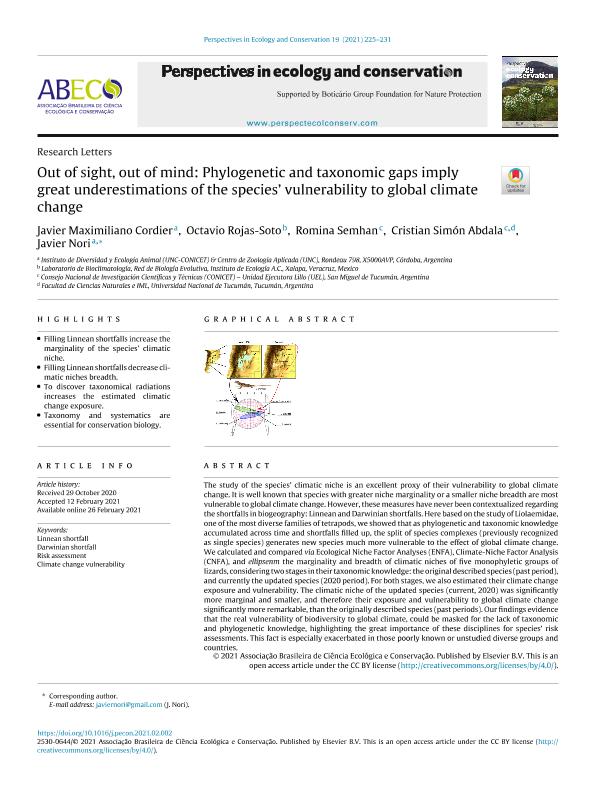Mostrar el registro sencillo del ítem
dc.contributor.author
Cordier, Javier Maximiliano

dc.contributor.author
Rojas Soto, Octavio
dc.contributor.author
Semhan, Romina Valeria

dc.contributor.author
Abdala, Cristian Simón

dc.contributor.author
Nori, Javier

dc.date.available
2022-10-06T13:45:36Z
dc.date.issued
2021-04
dc.identifier.citation
Cordier, Javier Maximiliano; Rojas Soto, Octavio; Semhan, Romina Valeria; Abdala, Cristian Simón; Nori, Javier; Out of sight, out of mind: Phylogenetic and taxonomic gaps imply great underestimations of the species’ vulnerability to global climate change; Associacao Brasileira de Ciencia Ecologica e Conservacao; Perspectives in Ecology and Conservation; 19; 2; 4-2021; 225-231
dc.identifier.issn
2530-0644
dc.identifier.uri
http://hdl.handle.net/11336/172200
dc.description.abstract
The study of the species’ climatic niche is an excellent proxy of their vulnerability to global climate change. It is well known that species with greater niche marginality or a smaller niche breadth are most vulnerable to global climate change. However, these measures have never been contextualized regarding the shortfalls in biogeography: Linnean and Darwinian shortfalls. Here based on the study of Liolaemidae, one of the most diverse families of tetrapods, we showed that as phylogenetic and taxonomic knowledge accumulated across time and shortfalls filled up, the split of species complexes (previously recognized as single species) generates new species much more vulnerable to the effect of global climate change. We calculated and compared via Ecological Niche Factor Analyses (ENFA), Climate-Niche Factor Analysis (CNFA), and ellipsenm the marginality and breadth of climatic niches of five monophyletic groups of lizards, considering two stages in their taxonomic knowledge: the original described species (past period), and currently the updated species (2020 period). For both stages, we also estimated their climate change exposure and vulnerability. The climatic niche of the updated species (current, 2020) was significantly more marginal and smaller, and therefore their exposure and vulnerability to global climate change significantly more remarkable, than the originally described species (past periods). Our findings evidence that the real vulnerability of biodiversity to global climate, could be masked for the lack of taxonomic and phylogenetic knowledge, highlighting the great importance of these disciplines for species’ risk assessments. This fact is especially exacerbated in those poorly known or unstudied diverse groups and countries.
dc.format
application/pdf
dc.language.iso
eng
dc.publisher
Associacao Brasileira de Ciencia Ecologica e Conservacao
dc.rights
info:eu-repo/semantics/openAccess
dc.rights.uri
https://creativecommons.org/licenses/by/2.5/ar/
dc.subject
LINNEAN SHORTFALL
dc.subject
DARWINIAN SHORTFALL
dc.subject
RISK ASSESSMENT
dc.subject
CLIMATE CHANGE VULNERABILITY
dc.subject.classification
Conservación de la Biodiversidad

dc.subject.classification
Ciencias Biológicas

dc.subject.classification
CIENCIAS NATURALES Y EXACTAS

dc.title
Out of sight, out of mind: Phylogenetic and taxonomic gaps imply great underestimations of the species’ vulnerability to global climate change
dc.type
info:eu-repo/semantics/article
dc.type
info:ar-repo/semantics/artículo
dc.type
info:eu-repo/semantics/publishedVersion
dc.date.updated
2021-12-03T20:14:15Z
dc.journal.volume
19
dc.journal.number
2
dc.journal.pagination
225-231
dc.journal.pais
Brasil

dc.journal.ciudad
Rio de Janeiro
dc.description.fil
Fil: Cordier, Javier Maximiliano. Consejo Nacional de Investigaciones Científicas y Técnicas. Centro Científico Tecnológico Conicet - Córdoba. Instituto de Diversidad y Ecología Animal. Universidad Nacional de Córdoba. Facultad de Ciencias Exactas Físicas y Naturales. Instituto de Diversidad y Ecología Animal; Argentina
dc.description.fil
Fil: Rojas Soto, Octavio. Universidad Nacional Autónoma de México. Instituto de Ecología; México
dc.description.fil
Fil: Semhan, Romina Valeria. Consejo Nacional de Investigaciones Científicas y Técnicas. Centro Científico Tecnológico - Tucumán. Unidad Ejecutora Lillo; Argentina
dc.description.fil
Fil: Abdala, Cristian Simón. Consejo Nacional de Investigaciones Científicas y Técnicas. Centro Científico Tecnológico - Tucumán. Unidad Ejecutora Lillo; Argentina
dc.description.fil
Fil: Nori, Javier. Consejo Nacional de Investigaciones Científicas y Técnicas. Centro Científico Tecnológico Conicet - Córdoba. Instituto de Diversidad y Ecología Animal. Universidad Nacional de Córdoba. Facultad de Ciencias Exactas Físicas y Naturales. Instituto de Diversidad y Ecología Animal; Argentina
dc.journal.title
Perspectives in Ecology and Conservation
dc.relation.alternativeid
info:eu-repo/semantics/altIdentifier/url/https://www.sciencedirect.com/science/article/pii/S2530064421000171
dc.relation.alternativeid
info:eu-repo/semantics/altIdentifier/doi/https://doi.org/10.1016/j.pecon.2021.02.002
Archivos asociados
